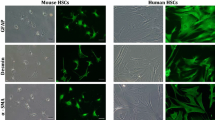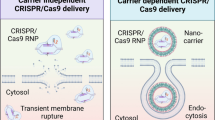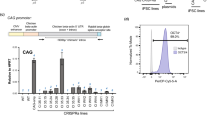Abstract
The gene CTNNB1 encoding β-catenin is mutated in about 30% of hepatocellular carcinoma, generally often combined with other genetic alterations. In transgenic mice, it has been shown that activation of β-catenin in more than 70% of all hepatocytes causes immediate proliferation leading to hepatomegaly. In this study we established a novel mouse model where β-catenin is activated only in individual, dispersed hepatocytes. Hepatocyte-specific expression of activated point-mutated β-catenin (human β-cateninS33Y) was established using the Cre/loxP system. Expression of several downstream targets of β-catenin signaling such as glutamine synthetase and several cytochrome P450 isoforms was confirmed by immunostaining. Only a minor portion of hepatocytes expressed the β-cateninS33Y transgene, which were mainly positioned as dispersed individual cells within the normal liver parenchyma. The hepatocytes with activated β-catenin did not show increased proliferation and the mice did not develop hepatomegaly. In conclusion, activated β-catenin in single hepatocytes induces a gene expression pattern in hepatocytes which is similar to that of Ctnnb1-mutated mouse liver tumors, but is apparently not sufficient to induce increased cell proliferation. Therefore, onset of proliferation seems to require concomitant activation of β-catenin in clusters of hepatocytes, suggesting a role of cell–cell communication in this process.






Similar content being viewed by others
References
Aydinlik H, Nguyen TD, Moennikes O, Buchmann A, Schwarz M (2001) Selective pressure during tumor promotion by phenobarbital leads to clonal outgrowth of beta-catenin-mutated mouse liver tumors. Oncogene 20(53):7812–7816
Benhamouche S, Decaens T, Godard C, Chambrey R, Rickman DS, Moinard C, Vasseur-Cognet M, Kuo CJ, Kahn A, Perret C, Colnot S (2006) Apc tumor suppressor gene is the “zonation-keeper” of mouse liver. Dev Cell 10(6):759–770
Borowiak M, Garratt AN, Wustefeld T, Strehle M, Trautwein C, Birchmeier C (2004) Met provides essential signals for liver regeneration. Proc Natl Acad Sci USA 101(29):10608–10613
Braeuning A (2009) Regulation of cytochrome p450 expression by ras- and Beta catenin-dependent signaling. Curr Drug Metab 10(2):138–158
Braeuning A, Schwarz M (2010) Beta-catenin as a multilayer modulator of zonal cytochrome P450 expression in mouse liver. Biol Chem 391(2–3):139–148
Braeuning A, Sanna R, Huelsken J, Schwarz M (2009) Inducibility of drug-metabolizing enzymes by xenobiotics in mice with liver-specific knockout of Ctnnb1. Drug Metab Dispos 37:1138–1145
Braeuning A, Singh Y, Rignall B, Buchmann A, Hammad S, Othman A, von Recklinghausen I, Godoy P, Hoehme S, Drasdo D, Hengstler JG, Schwarz M (2010) Phenotype and growth behavior of residual beta-catenin-positive hepatocytes in livers of beta-catenin-deficient mice. Histochem Cell Biol 134(5):469–481
Braeuning A, Kohle C, Buchmann A, Schwarz M (2011) Coordinate regulation of cytochrome P450 1A1 expression in mouse liver by the aryl hydrocarbon receptor and the {beta}-catenin pathway. Toxicol Sci 122(1):16–25
Cadoret A, Ovejero C, Saadi-Kheddouci S, Souil E, Fabre M, Romagnolo B, Kahn A, Perret C (2001) Hepatomegaly in transgenic mice expressing an oncogenic form of beta-catenin. Cancer Res 61(8):3245–3249
Cadoret A, Ovejero C, Terris B, Souil E, Levy L, Lamers WH, Kitajewski J, Kahn A, Perret C (2002) New targets of beta-catenin signaling in the liver are involved in the glutamine metabolism. Oncogene 21(54):8293–8301
Colnot S, Decaens T, Niwa-Kawakita M, Godard C, Hamard G, Kahn A, Giovannini M, Perret C (2004) Liver-targeted disruption of Apc in mice activates beta-catenin signaling and leads to hepatocellular carcinomas. Proc Natl Acad Sci USA 101(49):17216–17221
Devereux TR, Anna CH, Foley JF, White CM, Sills RC, Barrett JC (1999) Mutation of beta-catenin is an early event in chemically induced mouse hepatocellular carcinogenesis. Oncogene 18(33):4726–4733
Gebhardt R (1988) Different proliferative activity in vitro of periportal and perivenous hepatocytes. Scand J Gastroenterol Suppl 151:8–18
Gebhardt R, Mecke D (1983) Heterogeneous distribution of glutamine synthetase among rat liver parenchymal cells in situ and in primary culture. EMBO J 2(4):567–570
Gebhardt R, Cruise J, Houck KA, Luetteke NC, Novotny A, Thaler F, Michalopoulos GK (1986) Differential effect of growth factors on growth stimulation and phenotypic stability of glutamine-synthetase-positive and—negative hepatocytes in primary culture. Differentiation 33(1):45–55
Giles RH, van Es JH, Clevers H (2003) Caught up in a Wnt storm: Wnt signaling in cancer. Biochim Biophys Acta 1653(1):1–24
Hailfinger S, Jaworski M, Braeuning A, Buchmann A, Schwarz M (2006) Zonal gene expression in murine liver: lessons from tumors. Hepatology 43(3):407–414
Harada N, Miyoshi H, Murai N, Oshima H, Tamai Y, Oshima M, Taketo MM (2002) Lack of tumorigenesis in the mouse liver after adenovirus-mediated expression of a dominant stable mutant of beta-catenin. Cancer Res 62(7):1971–1977
Hoehme S, Brulport M, Bauer A, Bedawy E, Schormann W, Hermes M, Puppe V, Gebhardt R, Zellmer S, Schwarz M, Bockamp E, Timmel T, Hengstler JG, Drasdo D (2010) Prediction and validation of cell alignment along microvessels as order principle to restore tissue architecture in liver regeneration. Proc Natl Acad Sci USA 107(23):10371–10376
Krizhanovsky V, Yon M, Dickins RA, Hearn S, Simon J, Miething C, Yee H, Zender L, Lowe SW (2008) Senescence of activated stellate cells limits liver fibrosis. Cell 134(4):657–667
Loeppen S, Schneider D, Gaunitz F, Gebhardt R, Kurek R, Buchmann A, Schwarz M (2002) Overexpression of glutamine synthetase is associated with beta-catenin-mutations in mouse liver tumors during promotion of hepatocarcinogenesis by phenobarbital. Cancer Res 62(20):5685–5688
Loeppen S, Koehle C, Buchmann A, Schwarz M (2005) A beta-catenin-dependent pathway regulates expression of cytochrome P450 isoforms in mouse liver tumors. Carcinogenesis 26:239–248
Marx-Stoelting P, Mahr J, Knorpp T, Schreiber S, Templin MF, Ott T, Buchmann A, Schwarz M (2008) Tumor promotion in liver of mice with a conditional Cx26 knockout. Toxicol Sci 103(2):260–267
Moennikes O, Buchmann A, Romualdi A, Ott T, Werringloer J, Willecke K, Schwarz M (2000) Lack of phenobarbital-mediated promotion of hepatocarcinogenesis in connexin32-null mice. Cancer Res 60(18):5087–5091
Monga SP, Pediaditakis P, Mule K, Stolz DB, Michalopoulos GK (2001) Changes in WNT/beta-catenin pathway during regulated growth in rat liver regeneration. Hepatology 33(5):1098–1109
Murata M, Miyoshi Y, Ohsawa M, Shibata K, Ohta T, Imai Y, Nishikawa M, Iwao K, Tateishi H, Shimano T, Kobayashi T, Nakamura Y (2001) Accumulation of beta-catenin in the cytoplasm and the nuclei during the early hepatic tumorigenesis. Hepatol Res 21(2):126–135
Rignall B, Braeuning A, Buchmann A, Schwarz M (2011) Tumor formation in liver of conditional {beta}-catenin-deficient mice exposed to a diethylnitrosamine/phenobarbital tumor promotion regimen. Carcinogenesis 32(1):52–57
Sekine S, Lan BYA, Bedolli M, Feng S, Hebrok M (2006) Liver-specific loss of ß-catenin blocks glutamine synthetis pathway activity and cytochrome P450 expression in mice. Hepatology 43:817–825
Sekine S, Gutierrez PJ, Lan BY, Feng S, Hebrok M (2007) Liver-specific loss of beta-catenin results in delayed hepatocyte proliferation after partial hepatectomy. Hepatology 45(2):361–368
Tan X, Behari J, Cieply B, Michalopoulos GK, Monga SP (2006) Conditional deletion of beta-catenin reveals its role in liver growth and regeneration. Gastroenterology 131(5):1561–1572
Ueberham E, Arendt E, Starke M, Bittner R, Gebhardt R (2004) Reduction and expansion of the glutamine synthetase expressing zone in livers from tetracycline controlled TGF-b1 transgenic mice and multiple starved mice. J Hepatol 41(1):75–81
Wachstein M, Meisel E (1957) Histochemistry of hepatic phosphatases of a physiologic pH; with special reference to the demonstration of bile canaliculi. Am J Clin Pathol 27(1):13–23
Willert K, Nusse R (1998) Beta-catenin: a key mediator of Wnt signaling. Curr Opin Genet Dev 8(1):95–102
Acknowledgment
We acknowledge technical assistance by Elke Zabinsky, Johanna Mahr, and Silvia Vetter. We also acknowledge the gift of pβCatS33Y/CIneo by Dr. O. Müller (Dortmund, Germany), of CYP1A2 antiserum by Dr. R. Wolf (Dundee, UK), and of Lect2 antibody by Dr. S. Yamagoe (Tokyo, Japan). This work was supported by the Deutsche Krebshilfe [grant 106356], by the European Union [grant Cancer-Sys], by the Deutsche Forschungsgemeinschaft [grant SFB773], and by the Bundesministerium für Bildung und Forschung-funded network “Virtual liver”.
Author information
Authors and Affiliations
Corresponding author
Rights and permissions
About this article
Cite this article
Schreiber, S., Rignall, B., Braeuning, A. et al. Phenotype of single hepatocytes expressing an activated version of β-catenin in liver of transgenic mice. J Mol Hist 42, 393–400 (2011). https://doi.org/10.1007/s10735-011-9342-6
Received:
Accepted:
Published:
Issue Date:
DOI: https://doi.org/10.1007/s10735-011-9342-6




